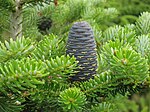Conifer cone
A confier cone (or pine cone) is an organ on plants in the division Pinophyta (conifers). It is the part of a tree that lets the tree reproduce. Its name in botany is strobilus, plural strobili.[1]






The familiar woody cone is the female cone, which makes seeds. The male cones, which make pollen, are usually smaller and much less easy to see, even when fully grown. The smaller plates of a cone are known as scales.
The male cone (microstrobilus or pollen cone) is similar across all conifers, differing only in small ways across each species, mostly in scale arrangement. Extending out from a central axis are microsporophylls (modified leaves). Under each microsporophyll is one or many microsporangia (pollen sacs).
Conifer cones and their seeds have been used for lots of different purposes. They are often used for decorations.[2] Some seeds, such as the seeds of pinyon pines, are used in prepared foods and baking.
Most mature cones are closed when wet and open when dry. In a few species, it takes fire to open the cones.[3]
References
change- ↑ Images of cones Arboretum de Villardebelle Images of various conifer-cones
- ↑ "[Cone] Results from TheSpruceCrafts.com". The Spruce Crafts.
- ↑ Dawson, Colin; Vincent J.F.V. & Rocca, Anne-Marie 1997. How pine cones open. Nature 390: 668.